The Old-New Synagogue in Prague
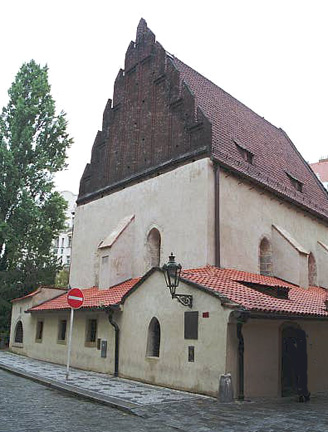
Altneuschul in Jewish quarter of Prague
The Old-New Synagogue on Maiselova Street
in Josefov, the old Jewish quarter of Prague, is the oldest synagogue
in Europe that is still in use as a house of prayer. The photo
above shows the Synagogue. Notice the two small windows on the
roof of the gable; they are called "eyelid windows."
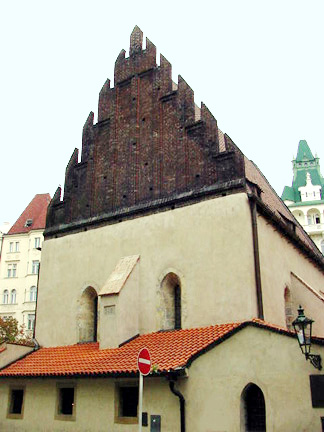
In 2000 when I visited Josefov, it was
the religious center for the Orthodox Jews in Prague, so it had
no museum displays inside. (There are two other synagogues still
in use in Prague - the High Synagogue just across the alley from
the Old-New Synagogue and the Jerusalem Synagogue.)
This synagogue got its strange name,
Altneuschul, which is German for old-new-school because at the
time that it was completed in 1275, it was the Neuschul or New
Synagogue, but by the 16th century when other new synagogues
were built in Prague, it became the Altneuschul or Old-New Synagogue.
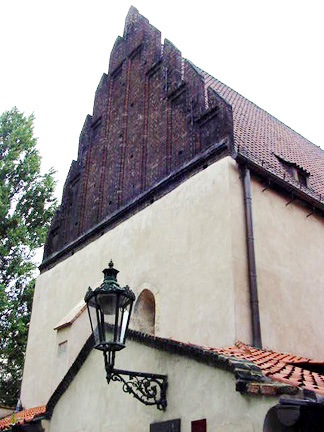
The architectural style is early Gothic
because at the time that the synagogue was built, Bohemia was
dominated by the Germans of the Holy Roman Empire. In those days,
the Jews were not allowed to be architects, so this building
was designed by Christian builders, believed to be the same architects
who designed the Franciscan St. Agnes Convent.
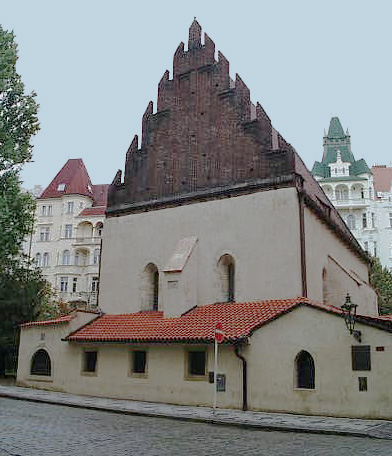 Old-New Synagogue in
Prague
Old-New Synagogue in
Prague
In the photograph above you can see the
sawtooth gable, which is constructed of brick, on the top of
the one-story building.
The interior of the main hall has a vaulted
ceiling like those typically seen in a Christian church. It is
the only medieval hall with this type of architecture still in
existence. The ceiling has six vault compartments supported by
two octagonal pillars. The unique design of the ceiling vaults
has five ribs.
The Old-New Synagogue is a single story
building, so the women's galley is not upstairs, as is customary.
Instead, there are side corridors where the women stand to view
the services through narrow slits in the wall. In Orthodox Synagogues,
the men and women are segregated and only the men are allowed
in the main hall.
In the center of the main hall of the
Old-New Synagogue is the bimah, which is like an elaborate wrought
iron cage. Above the bimah hangs a remnant of a red flag with
the Star of David, the Jewish symbol. In 1357, Charles IV, the
ruler of the Holy Roman Empire at the time, allowed the Jews
of Prague to have their own city flag. Another tattered red banner
hangs next to the Jewish flag. This was a gift from Holy Roman
Emperor Ferdinand III to the Jews for their help in stopping
an invasion by the Swedes in 1648 at the tail end of the Thirty
Years War. On the east wall is the Holy Ark which contains the
Torah scrolls.
This is the synagogue which Franz Kafka,
the famous writer, attended when he lived in Prague; his bar
mitzvah was held in the Old-New Synagogue. On the west wall of
the main hall, there is a glass case shaped like the two stone
tablets on which Moses chiseled the ten commandants. The case
is filled with tiny light bulbs which light up on the anniversary
of someone's death if the relatives have paid for this feature.
One of the lights is for Franz Kafka.
Men who enter the Old-New Synagogue as
tourists are required to cover their heads and paper hats are
provided. Women do not need any type of head cover.
The rear of the building is on the tree-lined
Parizska street which extends south to the Old Town square. From
Parizska street, you must descend some steps down to the alley
between the Old-New Synagogue and the Old Town Hall because the
streets were raised after the Old-New Synagogue was built. From
the front, it is not obvious that the synagogue is below street
level.
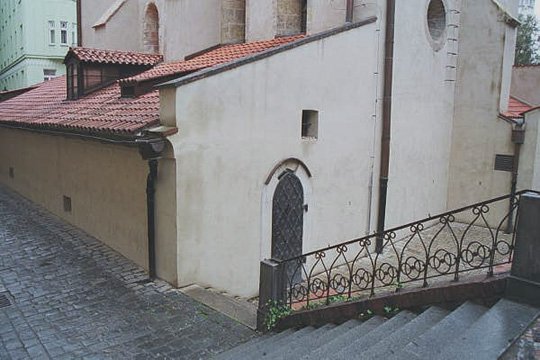
Rear view of the Old
Synagogue from Parizska street shows it is below street level
|